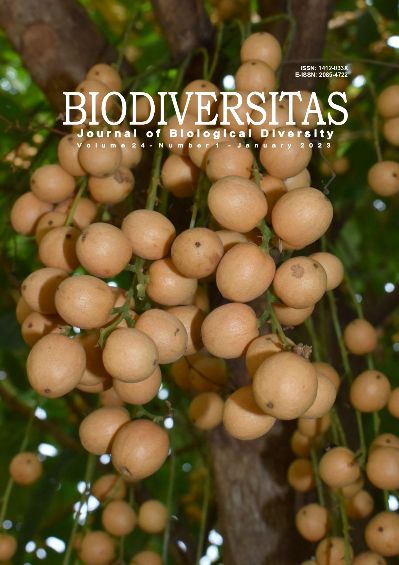Using biodiversity indices to assess the current state of tugai vegetation of the Amu Darya River, Uzbekistan
##plugins.themes.bootstrap3.article.main##
Abstract
Abstract. Rakhimova NK, Shomurodov KF, Sharipova VK, Saitjanova USH, Sadinov JS. 2023. Using biodiversity indices to assess the current state of tugai vegetation of the Amu Darya River, Uzbekistan. Biodiversitas 24: 467-472. Changes in plant associations of the tugai reserve of Uzbekistan (Amu Darya coast) due to climate change were considered. The state of associations represented by the xeromesophilic-mesothermal group of plants of the tugai (POTAMODENDRA), shrub (POTAMOTHAMNA) and herbaceous (POTAMOPOIA) vegetation types of the Amudarya tugai was analyzed. At the same time, ten associations were evaluated in a comparative aspect. An analysis of biodiversity within and between associations were carried out, various biodiversity indices (Shannon, Simpson, Margalef) were compared, and the sensitivity of the indices to various factors was assessed. In the tree layer, there was a significant decrease in the abundance of Populus euphratica, P. pruinosa, as well as the number of shrubs and perennial grasses. Alarming indicators of vegetation transformation have been identified using the ?- and ?-biodiversity indices. The evaluation results of vegetation in terms of biodiversity indices showed that due to the violation of the structural and functional organization, general degradation, simplification and impoverishment of the floristic composition, change of plant communities and xerophytization, significant changes occurred in the studied associations, as reflected in biodiversity indices. The results obtained will make it possible to understand the ways of formation and development of tugai vegetation, to identify the mechanisms of transformation of tugai forests on different ecological gradients (bioclimatic, hydrological, edaphic and anthropogenic), to assess the current state of tugai forests, to identify rare plant communities that need protection and to develop recommendations for their protection.

